
In any plant, when production increases above planned-for levels – whether due to sudden increased demand or unexpected constraints in the system – contract labor may be brought in as a quick fix. While this provides some flexibility in operations, increased labor costs is a problem.
Six Sigma can be used to optimize these changing labor costs and the accompanying productivity concerns. Cost accounting principles are also applied to these productivity improvements.
Background
Last year a flavors and food additives company in Asia, Amgis, had a surge in production in one of its product lines (liquids) due to the transfer of production from an affiliate and, simultaneously, an increase in sales. Because of the strict labor laws and strong union power in the Asian country, the company was reluctant to hire additional permanent employees as that could lead to over-employment within its workforce. Asking employees to work overtime also held little appeal, due to severe penalties related to overtime imposed by the government.
Amgis chose to go with a third option – hiring casual (i.e., temporary) labor to handle additional production loads when needed. The casual labor market in this locale is predominantly provided by one third-party service provider that has long had a good relationship with Amgis. This arrangement was supposed to help maintain the cost-effective use of casual labor by Amgis. Instead, Amgis was seeing an unreasonably high increase in casual labor cost.
Manufacturing Leverage Index
This index is calculated by subtracting the labor cost percent change from the production change percent change. For example, if production increases 10 percent and casual labor costs increase 20 percent during the same time period, the index is -10 percent. Ideally, the production percent change should be higher than the labor percent change; the goal is for the index to be a positive number and reflect “positive leverage.”
In February 2012, the finance and operation teams of Amgis were asked to control their casual labor costs. As part of this effort, the company began using a manufacturing leverage index as a key performance indicator (KPI); this index compared the casual labor costs to the increase in production volume. After four months, the KPI indicated there was no significant improvement in the relationship between casual labor and production. In a June meeting with internal and external stakeholders to address that disconnect, Amgis chose to use the continuous improvement methodology of Six Sigma to reduce the costs of casual labor.
Define
A process map of the current set up (Figure 1) revealed that the manpower requirement was based on the product order receipt; any shortfall was handled by additional casual labor. In theory, any increase in casual labor should match a corresponding increase in production volume. High casual labor costs is not a problem in and of itself. When the casual labor cost increase is higher than the production volume increase, however, it becomes a problem, as signified by a negative manufacturing leverage index.
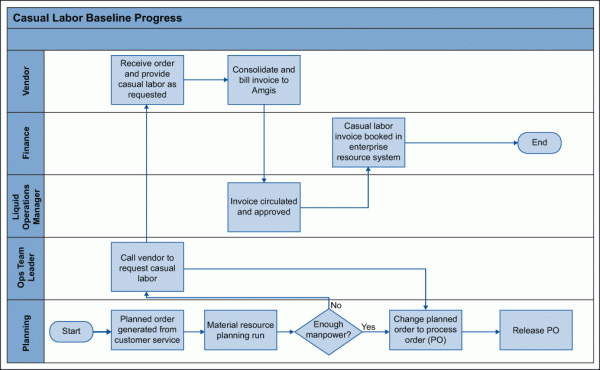
Measure
During the first half of 2012, contract hours (and costs) increased while volume remained constant or decreased compared to 2011, as shown in Figure 2. A cause-and-effect analysis was completed in July to better understand the various factors involved in this labor and production relationship (Figure 3).
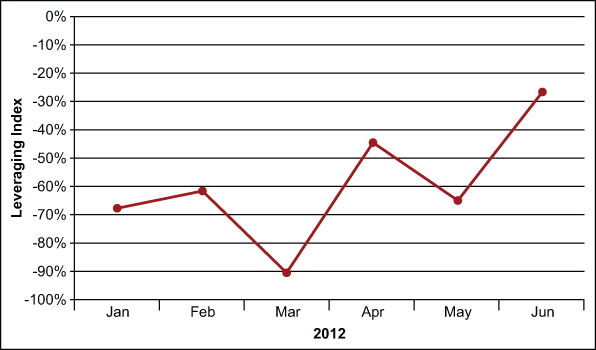

Analyze
After discussions with members of the operations team, the accounting department and the planning department, the various causes for the contract labor hiring were detailed and assessed through a rating system.
Not surprisingly, there were gaps in the planning process. When a production order was received, it was processed without checking whether it could be consolidated and processed with other orders. That resulted in unnecessary manpower spent on cleaning the machines and equipment after producing each individual order; preparing, measuring and weighing the raw material necessary to produce an order; and paperwork preparation.
In addition, proper accounting was not being performed. All of the casual labor invoices submitted to Amgis by the vendor were sent by mail, and then were handed manually within Amgis before being approved for payment. Invoices were not input into the accounting system until they were approved, which meant that there could be significant delays between an invoice being sent and an invoice being processed. In a few outlying instances, invoices went missing during the manual handling and were not found for six months.
The casual labor vendor was also a participant in improving the manufacturing leverage index. Upon Amgis’ request, it provided all labor request records for 2012 detailing who at the company had requested the labor, for which work area, for how long, etc. The records showed that the majority of requests were made by team leaders, but there were also unjustified requests made by nonauthorized persons.
The table below shows the results of this analysis. Among the root causes found for the continued high labor costs, the most significant were:
- Unauthorized requests, which indicated that the informal rules of who has authority to request casual labor were not known or being followed). The result was a temporary worker could be hired when there was not sufficient work to be done or when an employee could have been transferred from another department to help.
- Invoices not being authorized and processed on time. This reduced visibility of the problem, allowing more unnecessary casual labor hiring.
- Small batch orders that could have been combined with other orders for optimized production. As noted previously, this led to more work than necessary by employees to prepare the production line, and thus, created an artificial need for more casual labor to fill in.
| Root Cause Analysis of Contract Labor Hiring | |||||
| Degree of Severity* | Likelihood of Occurrence* | Ability to Detect* | Score (degree of severity x likelihood of occurrence x ability to detect) | Overall Ranking | |
| Unauthorized requests for casual labor (informal rules about who has authority not being followed) | 10 | 9 | 4 | 360 | 1 |
| Casual labor invoices not authorized and processed on time | 9 | 9 | 4 | 324 | 2 |
| Liquid production quantity not optimized | 7 | 6 | 4 | 168 | 3 |
| Incorrect expense recording | 4 | 6 | 2 | 48 | 4 |
| Time lag for invoice processing, insufficient accrual | 3 | 5 | 2 | 30 | 5 |
| *On a scale of 1 to 10, where 1 means the fewest concerns and 10 means the most concerns | |||||
Improve
Based on the root cause analysis, the most significant causes were addressed by corrective and preventive actions.
- All orders must be checked by the planning department to confirm the minimum production quantity. If an order does not meet the minimum production quantity, it will be held for consolidation with other orders to reach optimum production levels.
- No casual labor request can be made until there is confirmation that there is no idle or surplus manpower available from other internal production lines.
- Casual labor authorization was removed from team leaders and given only to production managers. These authorization points were communicated to the vendor; they are required to check that the person requesting additional labor is authorized to make that request by Amgis. All requests from nonauthorized persons will be summarily rejected.
- A formal, documented policy was created for casual labor employment.
In addition, Amgis asked the service provider to stop sending invoices by mail; all invoices must be sent electronically. This not only helped improve the speed of invoice processing but also helped get payment authorizations completed properly by using the existing workflow system of Amgis.
These improvements reduced the labor hours by up to 30 percent after July 2012. The manufacturing leverage index correspondingly improved, reaching as high as 60 percent from an earlier low of -90 percent, as shown in Figure 4. A revised process map that shows improvements in the vendor invoices, man power allocations and planning is given in Figure 5. The improvements were assessed by using hypothesis testing – a t-test for the mean labor hours before and after the improvements. The p-value is less than 0.05 so the null hypothesis is rejected, confirming that there is a significant difference in the mean value and the performance of the process has improved (Figure 6).
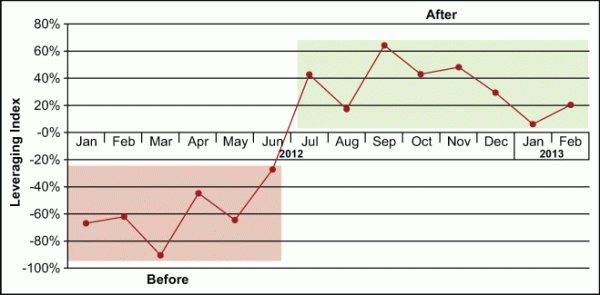
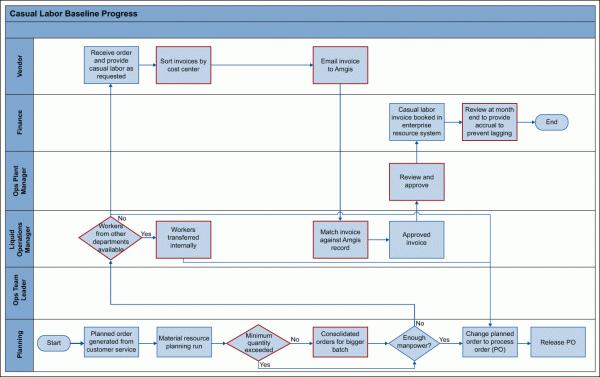
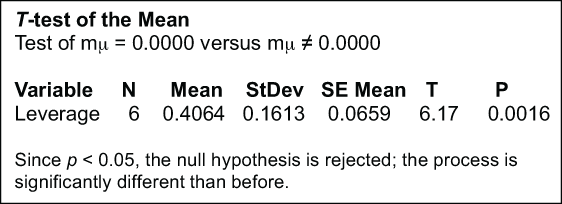
Control
The improvements were reviewed and confirmed as sustainable. The objective of Amgis remains to realize control based on a clearly defined system rather than leaving decisions up to individuals who define their own priorities and processes.
To continue to optimize production quantity, the company established a minimum process quantity in the workflow system. As a failsafe, a warning message will pop up if the minimum quantity is not reached with one order; the planning team will not let incomplete orders proceed to production. All invoices follow the workflow system, so that only the authorized person (or persons) can view and approve the invoices. A follow-up email will be sent automatically to remind those authorized staffers if there is an invoice pending their approval – a further automated tool to help sustain improvements. Finally, the policies for requesting casual labor have been clearly communicated internally across the production team and with the service provider.
Conclusion
This case study demonstrates the deployment of Six Sigma tools in finance for improvements in labor costs. The analysis involved four internal stakeholders (local operations, planning, finance and the regional management team) as well as one external stakeholder. All data was collected either from the company’s existing workflow system or provided by the casual labor vendor. Five people actively worked on this project while more than 10 contributed their time during a period of one month. No additional costs were spent on this improvement project.
Labor image via Shutterstock